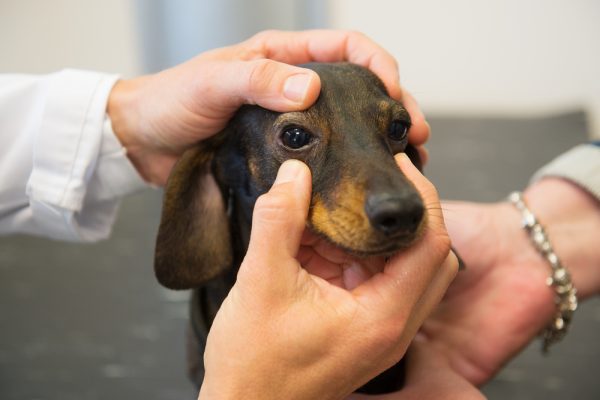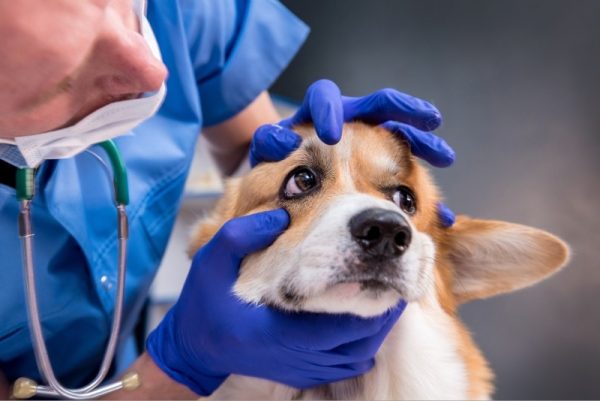In this article
They say a dog is a man’s best friend. It goes to a whole new level when the same dog welcomes a litter of puppies. When this happens, it becomes friendship coupled with immense responsibility. Taking care of a pregnant dog, and later on her puppies, is not easy; it requires a lot of dedication, knowledge, experience, and constant guidance from your veterinarian, and it is cost and time-intensive.
So, if you are considering breeding your dog, first make sure they are healthy and fit to have offspring through health testing done at your vet’s office, and then ensure that you are able to sell the puppies to good homes. You need to equip yourself with as much relevant information as possible to help you raise healthy puppies. You must also learn to identify a pregnant dog and how to care for the pregnant bitch.

All About a Dog’s Pregnancy and More
Puppies are fun to have around, but it’s important not to underestimate the time, responsibility, and dedication that goes into their care, even before they are born. The good thing is that the gestation period for dogs is shorter than in humans. But let’s uncover exactly how long dogs are pregnant for, what to expect during this time, and how to prepare for the upcoming litter.

Reproductive Cycle in Dogs
You must first understand a dog’s reproductive cycle. A female dog may go into heat every 5 to 11 months, depending on their breed size, with smaller dogs having even three heats per year, while giant breeds may only have one. On average, a medium-sized female dog will have two heats per year, roughly 6 months apart.
The reproductive cycle comprises four main stages, and “coming into heat” or “coming into season” generally refers to the stages called proestrus and estrus, while the female is receptive to breeding only during the actual estrus.1 Heat generally lasts for 14 to 21 days.
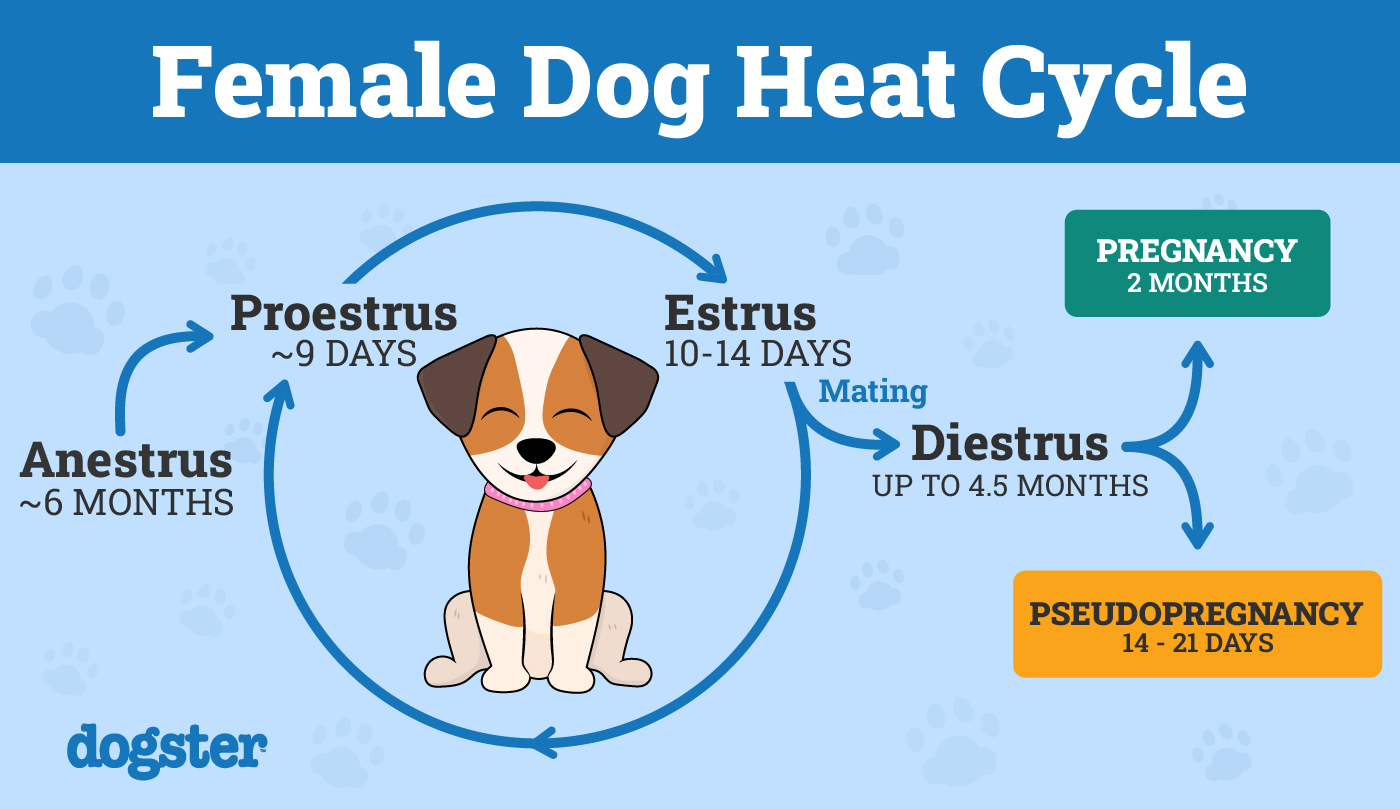
- Proestrus
Females attract males for around 6 to 11 days, but they don’t give in to the male’s advances until stage 2. Proestrus signs are bloody vaginal discharge and swelling of the vulva.
- Estrus
This period can last about 5 to 9 days with a range of 1 to 20 days. The bitch is now receptive to the male. Veterinarians perform blood tests and vaginal smears during proestrus and estrus to ensure the breeding of the dogs at the optimal time. Estrus signs are a decreased discharge that is now more watery and light in color, sometimes brownish, with a soft and wrinkled vulva as the swelling is subsiding. Flagging behavior is common as well, where the bitch moves the tail sideways or lifts it to expose the vulva and sign their receptivity or acceptance of the mount. Ovulation occurs during the estrus stage of the cycle.
- Diestrus
During this stage, the female is no longer attracting males nor does she allow any more mating. All the signs of a swelling vulva are gone, and the heat is over whether she became pregnant or not. It generally lasts around 60 days.
- Anestrus
Describes the period between heat cycles and it lasts for about 4 months but could last more than 6. During this time, the uterus regenerates from the previous estrus and diestrus or pregnancy.
A clear understanding of the reproductive cycle is crucial in determining the pregnancy time frame. A breeder should monitor the heat cycles and breeding to be able to estimate the date of conception, which will enable the veterinarians to perform accurate pregnancy diagnosis and calculate the expected due date period.


How Can You Tell if a Dog Is Pregnant?
There are no home pregnancy tests for dogs. A breeder has to visit a veterinarian’s office in order to find out if their dog is pregnant or not. Considering all dog’s pregnancy testing techniques are time-sensitive, you should tell your veterinarian the exact period your dog mated.
Here are the main methods that vets use to determine a dog’s pregnancy.
1. Palpation or Feeling Your Dog’s Abdomen
The veterinarian can conduct a palpation 21 to 30 days into gestation. At this stage, your vet may be able to feel an enlarged uterus or multiple swellings within it, depending on the breed and size of your dog. However, this will greatly depend on the individual dog because if they are tense, this cannot be performed easily.
Feeling an enlarged uterus is not a definitive way to diagnose a pregnancy, as it may be mistaken for organ enlargement, infection in the uterus called pyometra, or tumors. Only a veterinarian should do an abdominal palpation to avoid causing your dog or her puppies any harm. Presence of an enlarged uterus may not be a certain sign of pregnancy, and it would remain unknown if the puppies are viable.
2. Ultrasound
Most commonly, a pregnancy in dogs is confirmed using ultrasound. A vet can perform an ultrasound on the dog at any point starting from 25 to 35 days of gestation to determine if the dog is pregnant. This form of imaging can help detect fetal heartbeats, allowing you to know if the puppies are viable.
Ultrasounds also help the veterinarian calculate the fetus’ gestational age based on their body measurements, which helps in estimating the approximate time of expected delivery. It can be used in conjunction with other tests, such as progesterone, while planning for an elective cesarean in some dogs that may struggle to deliver naturally. However, an ultrasound is not used to predict the number of fetuses, as they can be easily miscounted using this method.
3. X-Rays
X-rays are an effective way to test for pregnancy and determine the number of puppies to expect from the dog. An X-ray will only give the desired results during the last 2 to 3 weeks of the pregnancy when the fetal spine and skull are visible. It can also be used after the whelping has finished to ensure there are no more puppies left in the uterus.
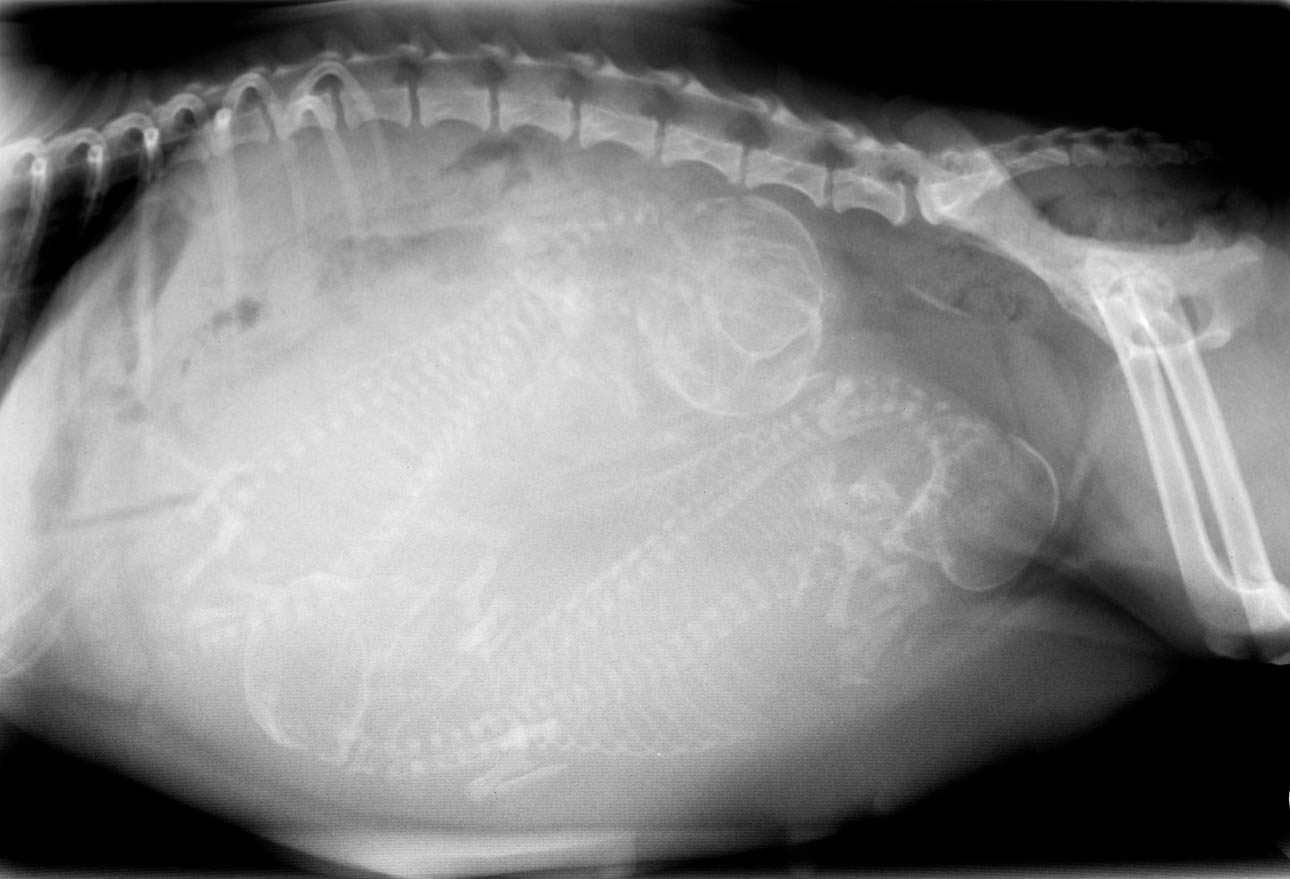
4. Hormone Tests
A veterinarian can perform a blood test to see if the hormone relaxin is being produced. Relaxin production happens only during pregnancy, making it an accurate test of a dog’s pregnancy, but it does not mean the pregnancy will be successful. The dog must be 22 to 30 days into the pregnancy for the test to be accurate.
For those that are tested early and have a negative result, the test can be repeated a week later. Small and toy breeds, particularly if they only have one or two puppies, may have a negative test result despite being pregnant.2

Gestation Period: How Long Are Dogs Pregnant?
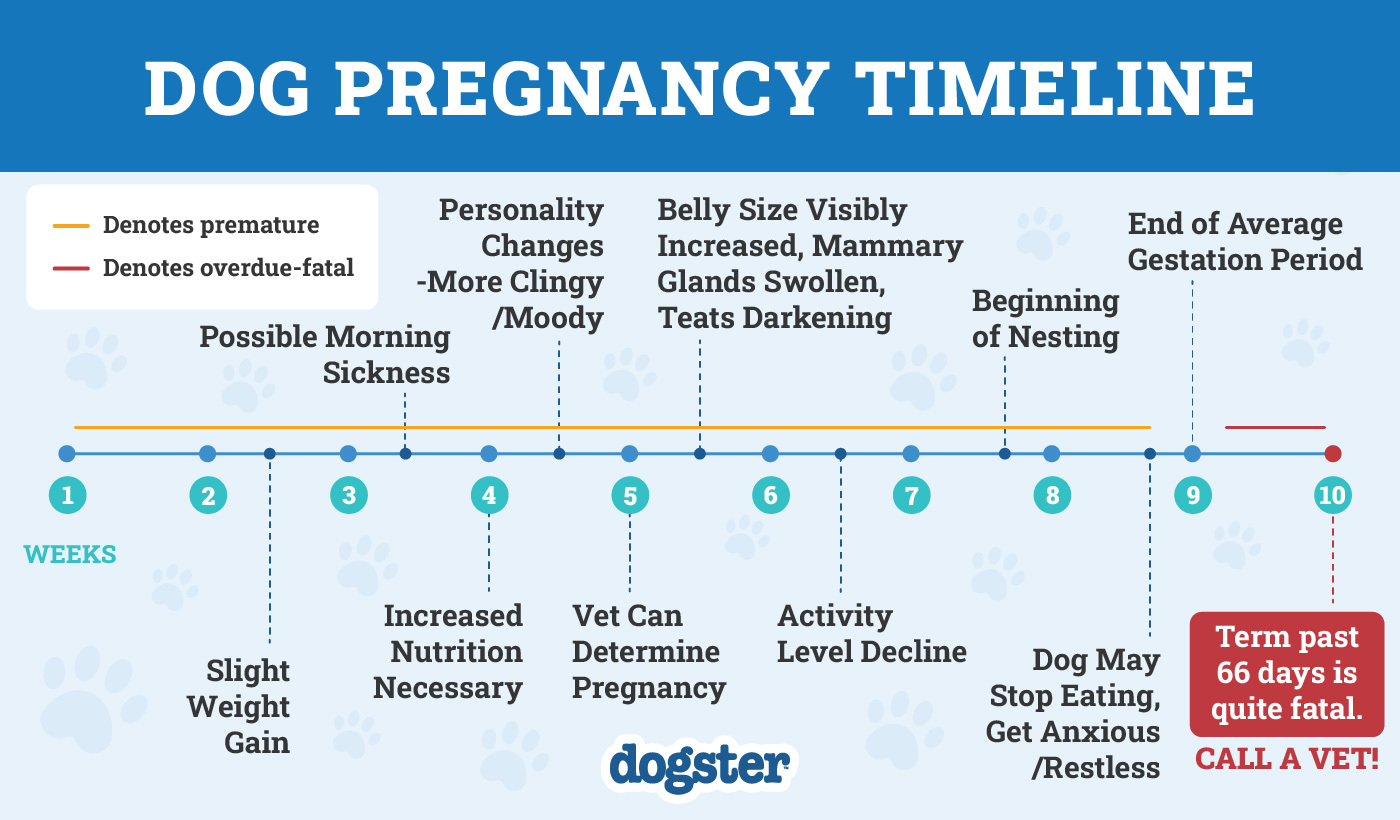
Dogs are pregnant for around 63 days from conception, approximately 2 months. But predicting the exact time of delivery is not always easy because the breeding date sometimes differs from the date of conception. Breed and litter size also determine the gestation period.
If you want a more precise plan for your breeding and gestation time frame, a veterinarian can conduct hormone testing and take vaginal smears to keep track of the reproductive cycle in order to estimate the time of ovulation. These kinds of tests can be performed to help you know the appropriate time to breed the bitch, the gestation time frame, and the potential delivery date.
Dogs have a much shorter gestation period than humans, just 9 weeks, and every day counts. Being familiar with the pregnancy time frame and expected due date is valuable for monitoring the bitch’s health, making required adjustments in her nutrition, predicting and planning whelping well in advance with your veterinarian, and in case your dog will need assistance in delivering her puppies.
An accurate hormone measurement shows the following gestation time frame:3
- 56 to 58 days from the beginning of diestrus
- 64 to 66 days from the initial rise of progesterone
- 58 to 72 days from the time breeding began
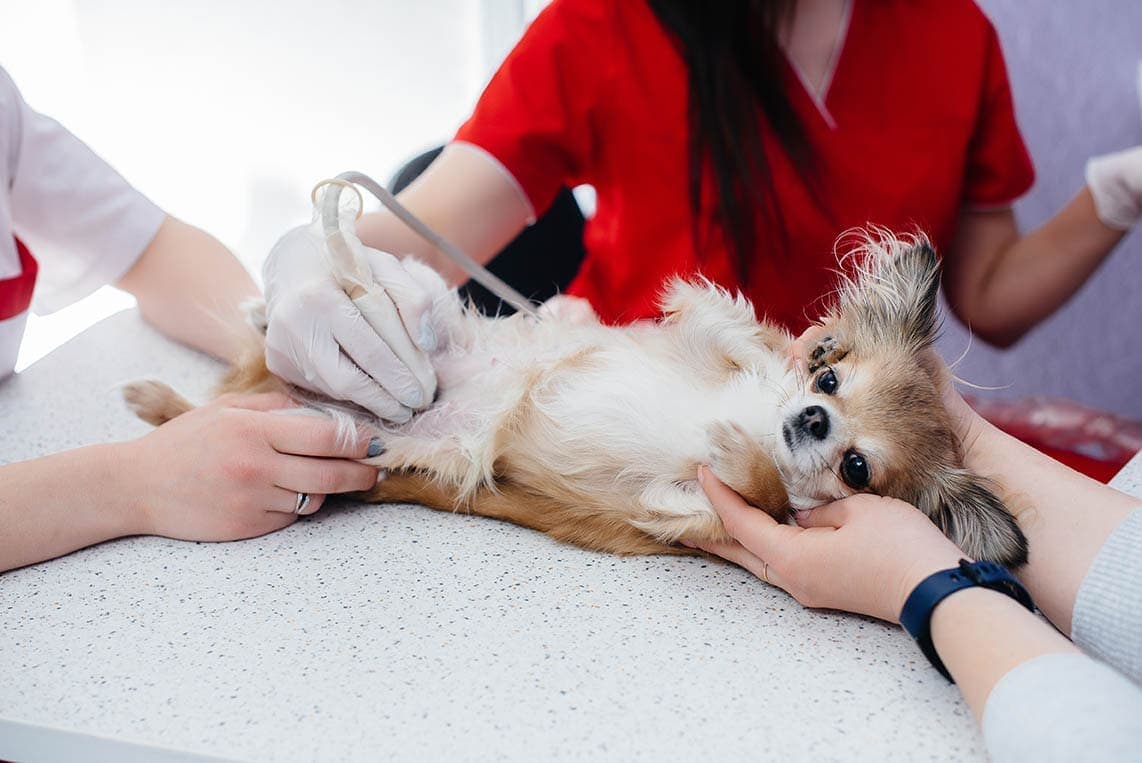

Signs of Pregnancy in Dogs
Through a choice of several tests, from feeling your dog’s abdomen to performing a blood test, ultrasound, or x-ray, your vet can tell with certainty if your dog is pregnant. But there are some other observable signs of pregnancy in dogs you can note as well. However, some signs of pregnancy in dogs can also be confused with several medical conditions, so if you think your dog is pregnant, bring her to a veterinarian.
Here are some of the signs that may point to a pregnancy in dogs for you to look for, but remember, most of them are non-specific and not necessarily related to pregnancy as such, as they can point to more serious health issues.
1. Change in Appetite
A pregnant dog’s appetite changes based on the individual dog and the pregnancy stage. Early into the pregnancy, you will notice less eating and maybe even occasional vomiting. But don’t be surprised if, as the pregnancy progresses, she eats more and seems to never get satisfied. These fluctuations are due to the changing hormones and the nutrition required to support the development of the puppy fetuses.
However, changes in appetite are not considered an obvious sign of pregnancy and may point to an underlying health condition.
2. Changes in Activity
If the dog’s activity level slowly decreases and the dog spends more time sleeping, that may be a sign of pregnancy. These signs are easy to notice in a typical energetic dog and hard to detect for dogs that enjoy dozing all day and have low activity levels. Many dogs will retain their usual activity levels in the very beginning of their pregnancy, while changes in activity may start to become noticeable towards the last few weeks before anticipated whelping, as the dog’s abdomen is getting bigger.
Again, a change in activity in a dog that has been mated does not necessarily mean they are pregnant and could indicate a health issue, so monitor their behavior closely and seek advice from your vet.
If you need to speak with a vet but can't get to one, head over to PangoVet. It's our online service where you can talk to a vet online and get the advice you need for your dog — all at an affordable price!

3. Increased Size of Mammary Glands
Dog’s nipples and mammary glands are normally small and not that noticeable but enlarge significantly toward the end of pregnancy. The flat areolas become more rounded and pronounced, while the mammary glands become quite obvious as they slowly fill up, particularly the ones toward the dog’s back legs. The nipples also become slightly dark red due to increased blood flow. As the due date is nearing, the nipples may even start to leak milk.

4. Unusual Behavior
A change in behavior may be another sign of a dog’s pregnancy. Some pregnant dogs tend to spend time at the owner’s side trying to get some attention. However, she also may seem irritated every time you want to give her attention. This varies depending on the dog. However, we cannot assume the dog is pregnant just based on the changes in their behavior, as these may also occur in cases of illness, infected uterus (pyometra), or false pregnancy.
5. Weight Gain
The abdomen enlarges in size as the puppies grow in the womb. Most times, this is the clearest sign of a dog’s pregnancy. Weight gain usually occurs a little later into the pregnancy. But if your dog’s abdomen is increasing in size and they are not feeling like themselves, are eating less, vomiting, drinking more, or are having a fever or discharge from their vulva, they may have developed pyometra or could be experiencing pregnancy loss, which requires veterinary care.
6. Nesting
As the gestation period nears its end, the dog begins to create a nest. She also becomes easily irritated and secluded. At this stage, it’s better to limit her interaction with the children. Please ensure she is calm and cared for while giving her some space during this time. You can also ensure she has an appropriate space to birth her puppies by providing a whelping box. Dogs that develop a false pregnancy may also nest and even produce milk, but their abdomen will not change in size, as they are not actually pregnant.


Caring for a Pregnant Dog
Once a dog’s pregnancy is confirmed, there are some steps you need to take to ensure the dog stays healthy throughout the pregnancy.
Proper Nutrition
You must see to it that the bitch receives proper nutrition when she is pregnant. Unless directed by the veterinarian, no dietary changes may be needed the first two-thirds of the pregnancy period if she is already feeding on quality dog food. Also, note that excess food can be harmful to the dog.
As she gains weight in the last weeks of gestation, it is recommended that you gradually increase food intake. At some stages of the pregnancy, some dogs require almost double the calories they would normally consume. Your veterinarian will be the best guide, but generally, it is recommended to change their diet to a calorie and nutrient-rich puppy food to support the pregnancy requirements, puppy development, and upcoming milk production. You should feed her with small and frequent meals throughout the day compared to single large quantities to avoid discomfort.
Exercise
Exercise for the pregnant dog should not be strenuous, especially during the first 2 weeks of pregnancy. After 2 weeks, normal but gentle exercise may resume until the dog’s belly begins to enlarge.
As birthing nears, the dog should stay away from other dogs and animals. Limit exercise to the indoors only so that she does not contract diseases that may be detrimental to her and the puppy’s health. It will also limit her exposure to canine herpes, a condition that leads to still-born puppies.

Veterinarian Visits
A prenatal checkup is essential before breeding your dog; vaccinations must also be up to date. A fecal exam helps rule out any intestinal parasites.
Regular visits to the veterinarian are advised during the gestation period. You should also inquire from the veterinarian what to do if an emergency arises during the last days of pregnancy. It’s best to have a plan established well ahead of time, be familiar with the signs of potential complications, and have your vet’s emergency phone numbers at hand. After the veterinarian confirms pregnancy, they will examine your dog in detail and get their previous reproductive history in order to determine anything that may hinder a normal whelped litter.
The veterinarian will then advise on the best method of delivery. For certain breeds of dogs that may not be able to deliver puppies naturally, they may recommend booking in an elective cesarean. If the dog got pregnant by accident, this is a good time to discuss the appropriate precautions you should take in the future, such as spaying, to prevent unplanned litters.
Speak to your veterinarian about deworming your dog. Most protocols will include worming before pregnancy, from around 40 to 45 days of gestation, and regularly while nursing puppies, who will also need a specific worming plan. Not every medication is safe to give to a pregnant dog or her puppies, and moreover, it might not be required, so please do not medicate your dog without a veterinarian’s prescription.
If your vet recommends deworming her, they will offer you the safest and most effective treatment to protect the puppies from getting worms from the mother after birth, allowing them to grow into healthy dogs.
Potential Dog Labor Complications
- Roughly 64 days passed after her last mating and there are no signs of whelping.
- The dog’s rectal temperature decreased more than a day ago and labor is not beginning.
- Failure to produce a puppy after 20 minutes of active contractions. Ensure you carry the already born puppies with you if the veterinarian recommends surgery.
- Bitch passes a green vaginal discharge but no puppy is delivered.
- More than 2 hours pass and the bitch only has weak contractions between pups, yet there are more inside.
- The dog’s labor started but no puppies were delivered within 2 hours.
- If there is a puppy or a sac stuck in the birth canal and your dog is straining but unable to deliver it.
- Serious trembling and collapsing are indications of a complication that could put the dog and puppies at risk.
- If you notice excessive blood or an unpleasant very smelly discharge.
- If all the placentas are not delivered, as there should be one per puppy.
- If puppies fail to nurse.
- Your dog is lethargic or has a fever (rectal temperature above 39.4°C or 103°F).
If your dog is a brachycephalic breed, they are much more likely to experience whelping complications, and these can be life threatening, both for your dog and her puppies. Make sure you arrange a delivery plan or an elective cesarean with your vet well in advance.

Conclusion
The pregnancy period can take a toll on you and the dog. Of course, the first decision is whether your dog is healthy and fit enough to be bred in the first place. That’s why you need to learn about a dog’s pregnancy beforehand so that you are better prepared to care for your soon-to-be dog mom. The more you learn about this process, the better prepared you will be, and when the pups are born, your work will be well cut out for you. You must be fully ready to raise healthy and well-socialized dogs. It’s a big responsibility, but you will hack it with the help and support from your vet.
Related Dog Reads:
- Microchipping Your Pet: Pros, Cons, & Costs (Is It Worth It?)
- 12 Tips for Building a Dog-Friendly Garden
Featured Image Credit: Litvinov Dmitry, Shutterstock




